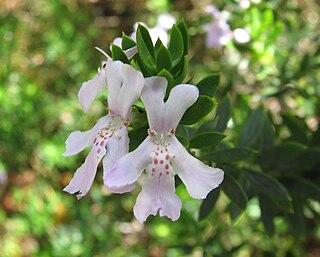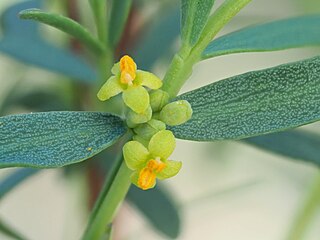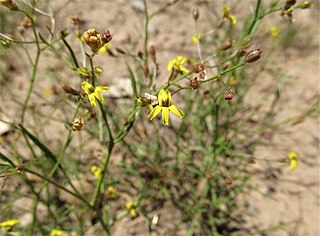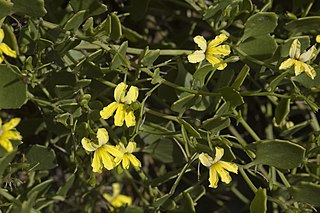
Prostanthera rotundifolia, commonly known as round-leaved mintbush or round-leaf mint-bush is a species of flowering plant in the mint family Lamiaceae, and is endemic to south-eastern Australia. It is an erect shrub with aromatic branches covered with short hairs and glands, egg-shaped to more or less round leaves and purple to mauve or pinkish flowers on the ends of branchlets.

Lobelia purpurascens, commonly known as white root or purplish pratia, is a flowering plant in the family Campanulaceae of eastern Australia. It is a small herbaceous, scrambling plant with white to pale pink flowers.

Dampiera stricta commonly known as blue dampiera, is a flowering plant in the family Goodeniaceae. It is a small sub-shrub with variable leaves and mostly blue, mauve or purple flowers.

Prostanthera ovalifolia, commonly known as the oval-leaf mintbush or purple mintbush, is a species of flowering plant in the family Lamiaceae and is endemic to south-eastern continental Australia. It is an erect shrub with egg-shaped leaves and groups of mauve to deep blue-purple flowers arranged in groups at the ends of branchlets.

Westringia glabra, commonly known as violet westringia, is a flowering plant in the family Lamiaceae and is endemic to Australia. It is a small shrub with oval-shaped leaves and pinkish, mauve or purple flowers.

Westringia dampieri, commonly known as shore westringia, is a flowering plant in the family Lamiaceae, it grows in South Australia and Western Australia. It is a small, dense shrub with white, mauve, cream or purple flowers.

Patersonia sericea, commonly known as purple flag or silky purple-flag is a species of plant in the iris family Iridaceae and is endemic to eastern Australia. It is a densely-tufted perennial herb with linear, sword-shaped leaves, broadly egg-shaped, bluish-violet tepals and an oval capsule.

Pimelea glauca, commonly known as smooth riceflower, is a species of flowering plant in the family Thymelaeaceae and is endemic to eastern Australia. It has elliptic to more or less lance-shaped or linear leaves and creamy-white flowers arranged in heads of seven or more on the ends of the stems, with four lance-shaped to egg-shaped bracts at the base of the inflorescence.

Pimelea pauciflora, commonly known as poison rice-flower, is a species of shrub in the family Thymelaeaceae. It has small yellow-lime flowers and green, smooth fleshy leaves, and is endemic to Eastern Australia.

Dianella longifolia, commonly known as blueberry lily, pale flax lily or smooth flax lily, or blue flax-lily, is a species of flowering plant in the family Asphodelaceae and is endemic to non-arid areas of Australia. It is a tufted, rhizomatous, perennial herb with grass-like leaves, pale blue, white or greenish flowers that have pale yellow anthers, and shiny, pale blue berries.

Goodenia coerulea is a species of flowering plant in the family Goodeniaceae and is endemic to the south-west of Western Australia. It is an erect, perennial shrub or biennial herb shrub with linear leaves at the base of the plant, sometimes with a few teeth on the edges, racemes of blue flowers and oval fruit.
Goodenia coronopifolia is a species of flowering plant in the family Goodeniaceae and is endemic to north-western Australia. It is a herb with mostly linear leaves, those at the base of the plant divided with narrow segments, racemes of yellow flowers with brownish-purple markings, and more or less spherical fruit.

Goodenia gracilis, commonly known as slender goodenia, is a species of flowering plant in the family Goodeniaceae and is endemic to Australia. It is an annual or perennial herb with linear to lance-shaped leaves and racemes of yellow flowers.

Goodenia pterigosperma is a species of flowering plant in the family Goodeniaceae and is endemic to south-coastal areas in the south-west of Western Australia. It is an erect to sprawling, glabrous perennial herb or shrub with linear to lance-shaped leaves mostly at the base of the plant, and racemes of dark blue flowers.
Goodenia purpurascens is a species of flowering plant in the family Goodeniaceae and is native to northern Australia and New Guinea. It is usually a perennial herb with linear to lance-shaped leaves at the base of the plant, and thyrses or panicles of purple flowers.

Goodenia rotundifolia is a species of flowering plant in the family Goodeniaceae and is endemic to eastern Australia. It is a prostrate to erect perennial herb with more or less round, toothed leaves and racemes of yellow flowers.

Goodenia varia, commonly known as sticky goodenia, is a species of flowering plant in the family Goodeniaceae and is endemic to southern Australia. It is an ascending to prostrate shrub with elliptic leaves, usually with toothed edges, and racemes or thyrses of yellow flowers.

Westringia angustifolia, commonly known as scabrous westringia, is a flowering plant in the family Lamiaceae and is endemic to Tasmania. It is a small, upright shrub with mauve or white flowers.

Pimelea argentea, commonly known as silvery leaved pimelea, is a species of flowering plant in the family Thymelaeaceae and is endemic to the south-west of Western Australia. It is an erect shrub with densely hairy young stems and leaves, the leaves linear to elliptic, and heads of white to yellow or greenish flowers, the male and female flowers on separate plants.

Pimelea latifolia is a species of flowering plant in the family Thymelaeaceae and is endemic to eastern Australia. It is a shrub with hairy young stems, egg-shaped leaves with the narrower end towards the base, and greenish-yellow to white, tube-shaped flowers.



















